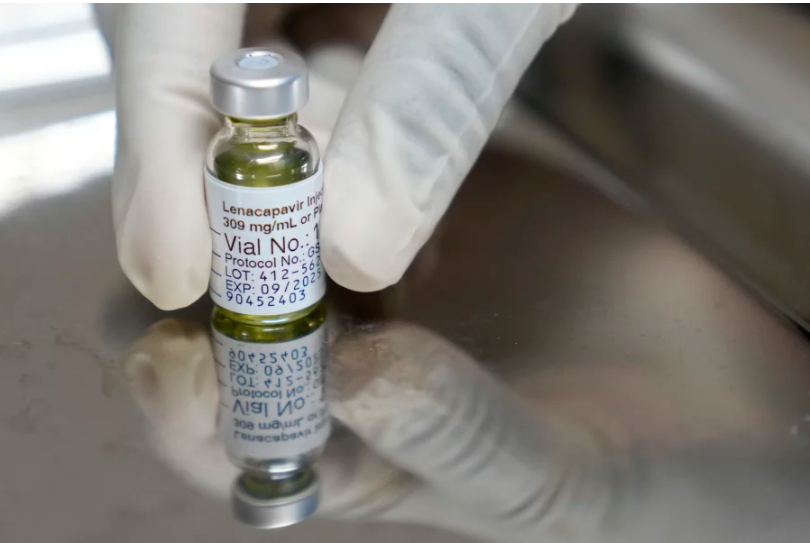
A drug with the potential to drastically curb the HIV epidemic just cleared its first regulatory hurdle.
On Wednesday, the Food and Drug Administration approved lenacapavir for the prevention of HIV. Clinical trial data from last year suggest just two injections a year provide near-complete protection against an HIV infection.
“It’s a milestone moment in the history of HIV,” says Daniel O’Day, chairman and CEO of Gilead Sciences, which manufactures the drug, which was already approved to treat HIV infection. “In our opinion, it’s the best tool yet in helping end the HIV epidemic for everyone, everywhere.” Others agree. In 2024, Science hailed lenacapavir as its “Breakthrough of the Year” in 2024.
The twice-yearly injection offers a more convenient alternative to the current standard of care for HIV prevention, a daily pill called Truvada. This pre-exposure prophylaxis (PrEP) is 99% effective at preventing HIV infection in clinical trials, but some people face significant barriers in taking a daily pill. One study found oral PrEP’s was only 26% effective in certain groups, in part because of skipped doses.
“Even though the pills work, the Achilles heel of that strategy is that people were not adhering to taking the pills as prescribed,” says Onyema Ogbuagu, an infectious disease researcher at Yale University.
A twice-a-year treatment could reach substantially more people, especially those who face stigma for taking a daily medication. For instance, researchers found that some single women in South Africa say taking a daily pill raises suspicion among their partners.
But the cost of the drug — roughly $28,000 a year — could price out many. While Gilead is taking steps to broaden access, the high price coupled with the U.S.’s steep cuts to foreign aid could prevent people in countries with the highest HIV burden from benefiting.
“Breakthrough of the year”
Existing PrEP pills block an enzyme that the HIV virus uses to copy its genetic material and reproduce. Lenacapavir works a bit differently, targeting the virus’s “capsid protein,” which houses its genetic material.
Lenacapavir’s power to prevent infection lies in its ability to disrupt this capsid, which prevents the virus from replicating for about six months. That power was demonstrated in two clinical trials, called PURPOSE 1 and PURPOSE 2, which were published last year in peer-reviewed journals.
PURPOSE 1 tracked over 5,000 cisgender women in South Africa and Uganda starting in 2021. Not a single woman who received lenacapavir contracted HIV over the course of the trial. PURPOSE 2 tracked more than 3,200 cisgender men, transgender women and men, and gender non-binary persons, finding HIV infections in just 2 of the participants who received lenacapavir, an efficacy of 96%.
“The efficacy for lenacapavir is just ridiculously high,” says Ogbuagu, who was involved in PURPOSE 2. “These are just like, unheard of numbers.
Uncertain access
The FDA’s decision makes lenacapavir available today in the U.S., which sees about 31,000 of the 1.3 million new HIV infections each year worldwide.
While the FDA’s decision has no bearing on access in other countries, it does build momentum for other regulatory authorities to approve the drug, says Carmen Pérez Casas, senior strategy lead at Unitaid, a United Nations agency that helps reduce the cost of treatments for HIV/AIDS, TB and malaria. European Union approval will be especially important in enabling approval in low- to middle-income countries, she says, and could happen later this year.
“But approval from a regulatory authority of a country doesn’t imply that we see access to this product yet,” says Pérez Casas. Ultimately, that will depend on cost and distribution mechanisms, especially in low and middle-income countries.
“For the moment, countries are paying approximately $40 per person per year for oral PrEP,” she says. “Anything that diverges drastically from that level of price will really impose a big stress on budget lines on HIV.”
In principle, lenacapavir could be manufactured for even less than that, according to Andrew Hill, a pharmacology researcher at Liverpool University. He and his colleagues calculated that the drug could be mass produced for just $25 for the two biannual doses, based on the current manufacturing costs. “That includes a 30% profit margin,” he says.
Gilead’s list price of $28,000 a year is far, far above that. “We have made a decision to price in line with the existing PrEP options,” says O’Day, the company’s CEO, but Gilead is working on several levels to provide lower-cost alternatives.
Gilead signed royalty-free licensing agreements with six generic manufactures last year, whom they’ll work with to provide lower-cost versions of lenacapavir to 120 lower-income countries with a high incidence of HIV. Several high-incidence but relatively higher-income countries like Brazil, Colombia and Mexico, are left out of that deal and could face higher costs, though the company says they’re working with such countries directly on tiered pricing.
Until those generic manufacturers get up and running, the company says it will provide up to 2 million people in these countries with lenacapavir at cost, with no profit going to Gilead.
“That looks like a lot of drug, but if there are 1.3 million new HIV infections every year, and you need to treat between 40-50 people with a preventative drug to prevent one infection, then 2 million is not going to do anything,” says Hill. “It’s not large enough to have any significant effect on the epidemic.”
If other countries follow the FDA’s lead, lenacapavir could become increasingly available in the coming months and years. But the Trump administration’s drastic cuts to foreign aid — including HIV prevention — could limit lenacapavir’s ultimate reach.
“It’s a very difficult situation,” says Hill. “Because of the cuts in funding, we’re going to see millions of people die from HIV in the next several years.”







